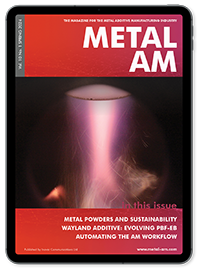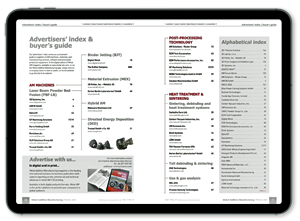The frenzy of media attention surrounding Artificial Intelligence (AI) dwarfs the past hype surrounding Additive Manufacturing (AM). Whether you look to the future with fear or excitement, there is no escaping the wave of change that is coming. Whilst we once again hear words like ‘revolution’ being used – to which so many have become immune – Dr Omar Fergani believes that we are now at a crucial point of convergence for AM and AI. Here, he explains why AM is in an especially strong position to leverage the potential of AI, with the power to transform many areas of our industry, from part design to machine operation, quality management and beyond.
... Read more »
The growth of metal Additive Manufacturing has been held back, believes Oqton’s Dr Ben Schrauwen, by a specific set of challenges: repeatability, cost, and the need for a high level of expertise. This article considers how next-generation software solutions that leverage Artificial Intelligence, cloud computing, and hybrid modelling are improving metal AM workflows. By addressing all three challenges, Schrauwen believes that metal AM can achieve faster and deeper adoption, leading to a more efficient and innovative future.
... Read more »
Additive Manufacturing offers the opportunity to transform industrial production. Currently, however, AM components are typically produced in only one material, which in many cases does not allow for full performance utilisation. In this article, Xiaoshuang Li and Arthur Seibel describe, through a heat sink case study, how multi-material design and manufacturing can increase component performance as well as integrate additional functionalities when using the Laser Beam Powder Bed Fusion (PBF-LB) process.
... Read more »
Three years ago, Metal AM magazine published a widely read article on the use of Laser Beam Powder Bed Fusion (PBF-LB) technology for precious metal jewellery production. Today, the continuing rise of sinter-based AM technologies promises to open up the jewellery sector yet further, with new opportunities for both mass-market production as well as bespoke pieces. Chiara Armbruster, Sonja Kappler, Carlo Burkhardt, Gerald Mitteramskogler and Apollinaria Frydmann offer an overview of this new generation of solutions and the state of the technology. A number of application examples are also presented.
... Read more »
Additive Manufacturing processes offer a high degree of design freedom. The Laser Beam Powder Bed Fusion of metals (PBF-LB/M), in particular, has established itself for series applications of complex-shaped parts in numerous industries. In this article, Prof Dr-Ing Christian Seidel considers the next major step in PBF-LB, which could offer designers unknown potential: the production of sensor-integrated AM parts. Methods and solutions for the manufacturing of sensor-integrated AM parts are presented and industry-relevant case studies showcased, illustrating the potential offered by sensor-integrated ‘smart parts.’
... Read more »
In the men’s track cycling team pursuit qualifying at the 2020 Olympics, broadcast live to a global audience, a handlebar part produced by metal Additive Manufacturing failed with catastrophic consequences for the rider, Australia’s Alex Porter. Six months later, a forensic analysis of the incident was published as a 170-page report. The good news is that the company that made the AM part, along with the technology itself, were cleared of blame. So: what went wrong, and what lessons can be learned? Robin Weston digs into the details. [First published in Metal AM Vol. 8 No. 2, Summer 2022]
... Read more »
Designs not driven by requirements increase the risk of an incomplete solution. This relatively simple statement gets to the heart of how designers need to be approaching AM, particularly when balancing the ‘design freedoms’ offered by the technology with the reality of viable and profitable production. Through an exploration of the ubiquitous AM bottle opener, John Barnes, Jennifer Coyne and Chelsea Cummings, The Barnes Global Advisors, and Jon Meyer, APWorks, explore how, by focusing on requirements, a data-driven approach ensures fully functional designs that deliver on multiple requirements for the lowest cost. [First published in Metal AM Vol. 7 No. 1, Spring 2022]
... Read more »
The ability to ‘design out’ distortion during sintering is seen as key to enabling the faster commercialisation of metal Binder Jetting (BJT). The Simufact Additive software platform, now on the third release of its BJT sintering module, is able to accurately simulate the sintering process, predicting shrinkage, slumping and friction-related distortion, either with or without ‘live’ and ‘ceramic’ setters, resulting in a downloadable ‘compensated’ component geometry to be fed directly to the AM machine. In this article, Jeff Robertson explores through case studies how The ExOne Company has been using the software in its AM adoption and R&D centres to optimise customer parts for sintering. [First published in Metal AM Vol. 6 No. 3, Autumn 2021]
... Read more »
Support structures have been there for us since the beginning of AM, anchoring us to a firm foundation and taking the heat when things get intense. But they also bring with them baggage that is now holding us back, blocking channels and taking up valuable time and materials. Is it time to break free? In this article, Jennifer Coyne and John Barnes, of The Barnes Global Advisors, explore our journey so far with support structures, their advantages and disadvantages, and consider the opportunities and impact of the shift towards ‘support free’ strategies. Through three case studies, cost and productivity of conventional and ‘support free’ production are compared. [First published in Metal AM Vol. 6 No. 3, Autumn 2021]
... Read more »
The uptake of Additive Manufacturing by industry, believes Autodesk’s Paul Sohi, has been both stratospherically high and confusingly low. In explaining and addressing this dichotomy, Sohi explores the multiple potentials of AM when approached by taking a more holistic view of design challenges. Whilst there is no doubt that the popularisation of AM technology is influencing how we design products by shifting the design language to embrace more complex or nonstandard forms, Sohi believes that this is where the application of AM seems to be stagnating. So, how can we close the loop from design to manufacturing? [First published in Metal AM Vol. 7 No. 2, Summer 2021]
... Read more »
Metal Additive Manufacturing technologies offer the potential for true mass customisation, but in order to leverage this opportunity, new, complex workflows and business models have to be implemented. In this article, Siemens Digital Industries Software’s Ashley Eckhoff considers the challenges when addressing the topic, from the addition of further complexity, to an already challenging Additive Manufacturing workflow, to traceability and regulation. By adapting the AM process to meet these needs, companies can reap the benefits of new markets uniquely suited to this technology. [First published in Metal AM Vol. 7 No. 2, Summer 2021]
... Read more »
An unexpected consequence of the COVID-19 pandemic has been its impact on the multibillion dollar semiconductor microchip market: at the very same moment as demand for consumer electronics skyrocketed due to global lockdowns, the supply of semiconductors was bottlenecked by production disruptions. Now, supply chain shortages threaten the production volume of the industries dependent on these parts. Scott Green and Niels Holmstock, 3D Systems, and Lieven Vervecken and Gert-Jan Paulus, Diabatix, explore how metal AM can be used to increase efficiency in semiconductor fabrication and boost the speed at which these vital components can be produced. [First published in Metal AM Vol. 7 No. 2, Summer 2021]
... Read more »





Join our community